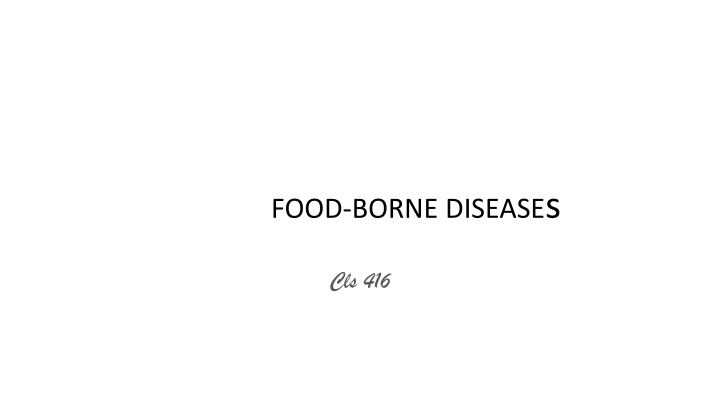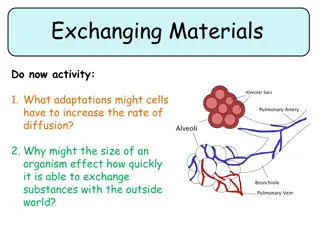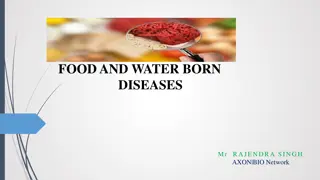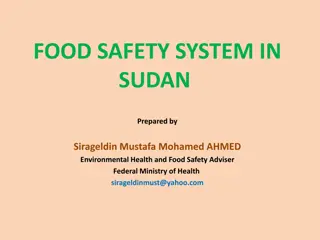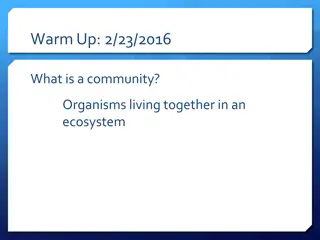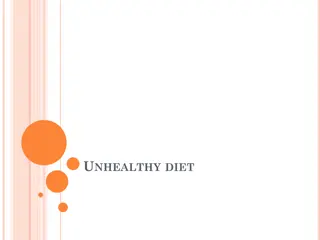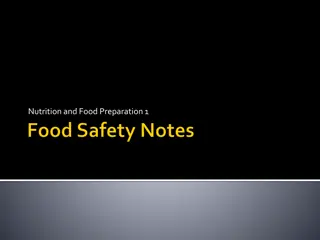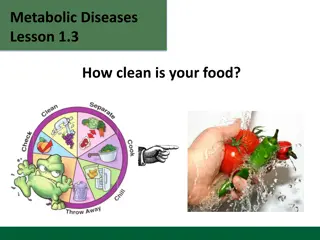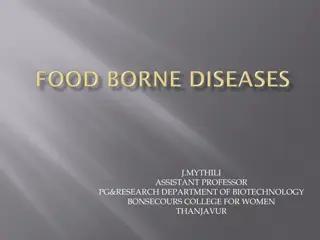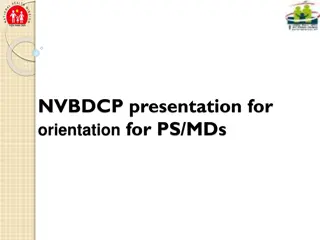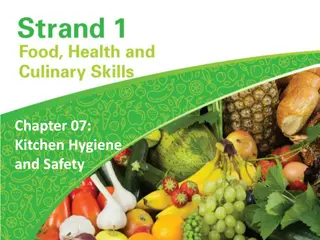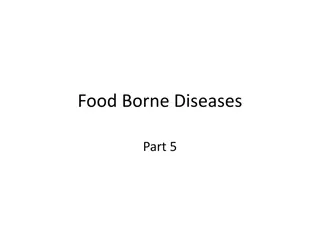Food-Borne Diseases: Definition, Classification, and Organisms
Food-borne diseases are illnesses caused by consuming contaminated food or beverages. They can be infections or poisonings, with over 250 different diseases described. Classification includes food-borne infections and intoxications. Pathogens such as bacteria, viruses, and parasites are associated with these diseases. Understanding the differences between food-borne infections and intoxications is crucial, as they have distinct symptoms and modes of transmission. Organisms like bacteria, fungi, and viruses play a significant role in food-borne illnesses.
Download Presentation

Please find below an Image/Link to download the presentation.
The content on the website is provided AS IS for your information and personal use only. It may not be sold, licensed, or shared on other websites without obtaining consent from the author.If you encounter any issues during the download, it is possible that the publisher has removed the file from their server.
You are allowed to download the files provided on this website for personal or commercial use, subject to the condition that they are used lawfully. All files are the property of their respective owners.
The content on the website is provided AS IS for your information and personal use only. It may not be sold, licensed, or shared on other websites without obtaining consent from the author.
E N D
Presentation Transcript
FOOD-BORNE DISEASEs Cls 416
FOOD-BORNE DISEASEs Food-borne illness is defined as any illness occures due to the consumption of contaminated food or beverages. food borne microbial pathogen, or a preformed microbial toxin, or another poison such as a poisonous chemical that contaminated the food and/or beverage, leads to one of the many different food borne illnesses.
FOOD-BORNE DISEASE More than 250 different food borne diseases have been described. Most of these diseases are infections, caused by a variety of bacteria, viruses, and parasites. Other diseases are poisonings, caused by harmful toxins or chemicals that have contaminated the food, for example, poisonous mushrooms or heavy metal contamination.
FOOD-BORNE PATHOGENS Protozoa Giardia lamblia Entamoeba histolytica Helminthes Taenia spp Viruses Norwalk virus Hepatitis A virus Prions new variant CJD Bacteria Toxin producing: Clostridium botulinum, Staphylococcus aureus Infectious: Salmonella spp., Listeria monocytogenes, shigella, E.coli, Salmonella typhi
Classification of food borne diseases Food borne diseases are classified into: 1. Food borne infections and 2. Food borne intoxications
Food borne infections vs. intoxication Intoxications toxins ( natural / preformed bacterial / chemical) Infections Bacterial / Viral / parasite Invade and or multiply in lining of intestine or secerte an enterotoxin No invasion or multiplication S/s Vomiting , nausea, diarrhea, weakness, resp. failure , numbness, sensory/motor dysfunction S/s Diarrhea , nausea, vomiting , abdominal cramps, fever Not communicable Communicable-spreads from person to person Factors-inadequate cooking, cross contamination , poor personal hygiene , bare hand contact Factors-inadequate cooking , improper handling temperatures
Organisms associated with food borne disease Infection Intoxication poisoning Bacteria - Staph aureus -C. botulinum - Bacillus cereus Fungi (mycotoxins) -Aspergillus, - Fusarium, - penicillium Bacteria -Campylobacter -Salmonella -Vibrio -Listeria monocytogenes -Yersinina enterocolitica -Shigella Viruses - Norovirus -Rotaviruses -Hepatitis Avirus - -
Food- borne infection Food borne infections are caused by the entrance of pathogenic microorganisms contaminating food into the body, and the reaction of the body tissues to their presence. These can either be fungal, bacterial, viral or parasitic Mycotic food borne infections include Candida spp., Sporothrix spp. etc.. Viral food borne infections include hepatitis A , Norwak virus and poliomyelitis virus
FOOD BORNE INTOXICATIONS These are diseases caused by consumption of food containing: Biotoxicants which are found in tissues of certain plants and animals. Metabolic products (toxins) formed and excreted by microorganisms (such as bacteria, fungi and algae), while they multiply in food, or in gastrointestinal tract of man. Poisonous substances, which may be intentionally or unintentionally added to food during production, processing, transportation or storage.
Food Infections Etiology Incubation period Clinical findings Characteristic food Bacillus cereus 6-24 hours watery diarrhoea Meat, poultry, rice Clostridium perfringens 10-15 hours watery diarrhoea Meat, poultry, pie, stews Salmonella sp. 12-48 hours Enteritis, enterotoxin Poultry, eggs, meat Salmonella typhi Salmonella paratyphi 14-21 days Enteric fever Fecal-oral, (human) Carriers, water, food Shigella sp. 12-48 hours Dysentery, invasion, enterotoxin Fecal-oral, (human) water
Food Infection----cont Etiology Incubation period Clinical findings Characteristic food Vibrio parahemolyticus 10-24 hours watery diarrhoea shellfish Vibrio cholerae 12-36 hours enterotoxin(rice water stool) watery diarrhoea, dehydration, vomiting water (Fecal oral) Campylobacter sp. 3-5 days Enterotoxin dysentary Poultry, milk Yersinia enterocolytica 1-2 days Vomiting , diarrhoea, bacterimia Pork & meat, raw milk, leftover foods E.Coli (ETEC,) ( EHEC) 12-24 hours Travelars diarrhoea Haemorrhagic colitis , Kidney failure water,, raw vegetables, meat, water
FOOD BORNE INTOXICATIONS Food borne intoxications have short incubation periods (minutes to hours) and are characterized by lack of fever. Food borne intoxications can be classified into: Bacterial intoxications Fungal intoxications Chemical intoxication Plant toxicants, and Poisonous animals.
Food (Bacterial) intoxication poisoning Incubation period Etiology Clinical Findings Characteristic Food Bacillus cereus 1-6 hours Vomiting, Diarroea Fried rice Staph aureus 1-8 hours Vomiting, Diarroea Meat,custards, mayonaise Clostridium botulinum 1-4 days Neuromuscular paralysis Canned food Vegetables, fruits, meat,fish (alkaline pH)
Food- borne infection Prions Prions-proteinaceous infectious particles. They contain proteins but no DNA, and are linked to a group of diseases called the TRANSMISSIBLE SPONGIFORM ENCEPHALOPATHIES= cause breakdown of the nerve cells. A prion is essentially a variation on a normal protein which is folded in an unusual way. It causes disease not by replicating, but by triggering other proteins to also turn into prions This chain reaction of changes eventually leads to the build up of plaques in the nervous system, and the symptoms of spongiform disease.
Food borne infection Prions Vacuoles in affected brain tissue
KURU It is caused by an infectious protein(Prion) found in contaminated human brain tissue. First recognised among New Guinea tribesman in the 1950s. In the local language, kuru means shivering or trembling this reflected the severe loss of coordination associated with the disease, which was fatal within 2 years of onset. The disease is caused by ritual cannibalism, particularly by women and children, who consume the brains of dead relatives.
VIRAL FOOD-BORNE INFECTIONS Viruses are common pathogens transmitted through food. Hepatitis A and Norwalk-like virus (Novovirus) are the most important viral food borne pathogens. These viruses are highly infectious and may lead to widespread outbreaks
Infectious hepatitis A The incubation period is long, being an average of 30 days (range 15-50 days). It is a systemic infection characterized by gastrointestinal manifestations and liver injury, fever, malaise anorexia, nausea, abdominal discomfort, bile in urine and jaundice. The duration of the disease could be from a few weeks to several months
Norwalk-like virus (Novovirus) food borne infection Novovirus infection is relatively mild with an incubation period of 3 days. Clinical manifestations/symptoms include vomiting and diarrhea, and rarely convulsions. Asymptomatic infection are common and may contribute to the spread of the infection. Infections have resulted from consumption of raw oyesters.
